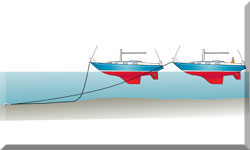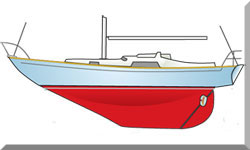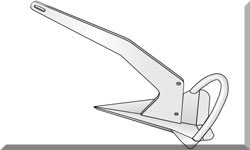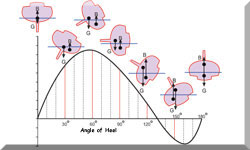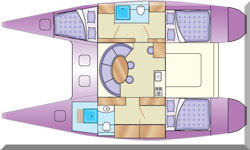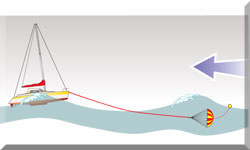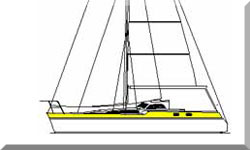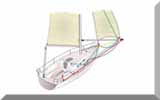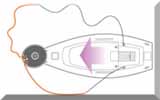- Home
- Marine Electrical Systems
- Sailboat Current Draw Calculation
A Sailor's Guide to Sailboat Current Draw & 12V Electrics
In a Nutshell...
Getting a firm handle on your boat's 12V electrical system starts with one key calculation: figuring out your daily sailboat current draw calculation. This tells you exactly how much power you'll use over 24 hours. By understanding your total power consumption, you can correctly size your domestic battery bank and design a charging system that keeps your batteries healthy and your boat running smoothly. It's the first critical step to ensuring you have a reliable, self-sufficient electrical system at sea, avoiding dead batteries and potential system failures.
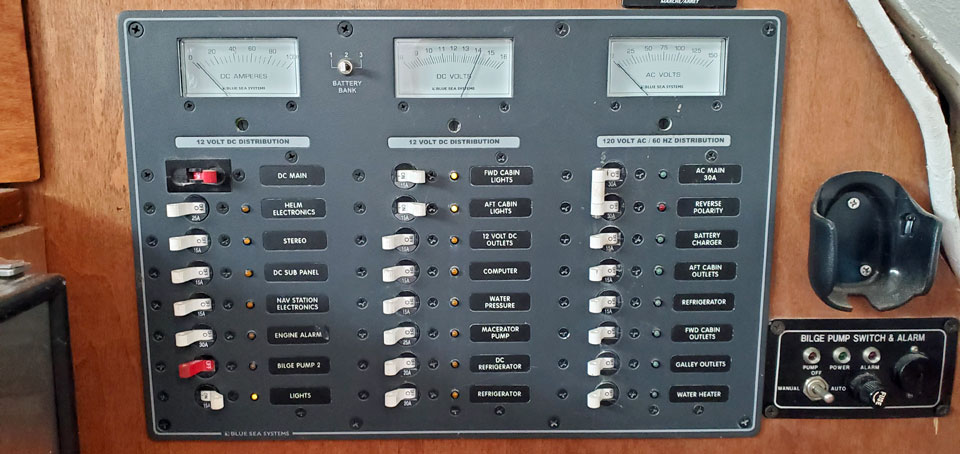 This control panel will make it a simple matter to ascertain the current draw of each circuit
This control panel will make it a simple matter to ascertain the current draw of each circuitTable of Contents
Assessing Your Daily Electrical Needs
Putting It All Together: An Example Calculation
From Theory to Practice: Why This Matters at Sea
Sizing Your Battery Bank & Charging Regime
The Importance of a Balanced Charging Regime
Cutting Down on Your Consumption
Summing Up
FAQs
Assessing Your Daily Electrical Needs
The world of marine electrics can seem complicated, but it's really about balancing three things: your daily power usage (current draw), your battery bank's capacity, and your charging methods. Let's focus on the first part of that equation—calculating your current draw over a typical 24-hour period.
First, you'll need to list every electrical item on board that draws power from your domestic circuit. You can find the current rating for each piece of equipment on its nameplate or in the manual. This rating is usually given in watts (W) or amps (A). Since our system is 12V, we need to convert everything to amps to make our calculations consistent.
The relationship between power and current is straightforward:
Power (W) = Current (A) \times System Voltage (V)$$
To get the amps from a wattage rating, simply rearrange the equation:
Current (A) = Power (W) \div System Voltage (V)$$
For example, a 6 watt LED navigation light on a 12 volt system draws 0.5 amps. If you use it for 10 hours a day while underway, it will have consumed 5 amp-hours (Ah) of power from your battery bank.
Putting It All Together: An Example Calculation
Working through this for every piece of equipment will help you build a clear picture of your total daily consumption. The following table provides a useful example of a typical 30-foot cruising sailboat's domestic current draw at anchor and underway.
| Equipment | Current Draw (A) | Daily Usage (Hours) | Daily Consumption (Ah) |
|---|---|---|---|
| Navigation Lights | 0.5 | 12 | 6.0 |
| Anchor Light | 0.25 | 12 | 3.0 |
| Cabin Lights | 2.0 | 3 | 6.0 |
| Refrigeration | 4.0 | 8 | 32.0 |
| Autopilot | 5.0 | 10 | 50.0 |
| VHF Radio (Standby) | 0.5 | 24 | 12.0 |
| Laptop/Tablet | 1.5 | 2 | 3.0 |
| Water Pump | 3.0 | 0.5 | 1.5 |
| Instruments (GPS, Wind) | 1.5 | 24 | 36.0 |
| Inverter (Standby) | 0.8 | 24 | 19.2 |
| Entertainment System | 2.0 | 1 | 2.0 |
| Total Underway | 170.7 Ah | ||
| Total at Anchor (excl. Nav/Autopilot) | 108.7 Ah |
Keep in mind, this is only an estimate. Conditions change. Your fridge will work harder in the tropics, and your autopilot will use more power in a lively sea than in a calm one. These calculations give you a robust benchmark, but it’s always wise to add a healthy margin for error, accounting for start-up currents and other minor losses. This estimate shows you'll need to replenish roughly 170Ah each day when underway.

But being of a kind and generous nature, I've made these calculations very easy for you with an Excel spreadsheet.
With this you can quickly find the daily current draw for your boat, and see how adjusting the period of use of each item (or switching one or more of them off altogether) affects the drain of your battery.
You can get your hands on my Live, Customizable Daily Current Calculator right here!
From Theory to Practice: Why This Matters at Sea
With more than a few ocean seamiles under my keel, I can tell you that an accurate understanding of your current draw isn't just an academic exercise—it’s the cornerstone of a reliable cruising setup. A battery monitor is invaluable, but the fundamental calculation provides the 'why' behind the numbers. It allows you to anticipate your power needs and make informed decisions on the fly—whether to run the engine for an extra hour, use solar panels more effectively, or simply switch off a non-essential appliance. Without this foundational knowledge, you're sailing blind, risking undue strain on your batteries that shortens their life and can leave you in a real bind. By knowing your current draw, you can choose a battery bank that meets your needs without being oversized and overweight, and you can size your charging sources (engine alternator, solar, wind) to match.
Sizing Your Battery Bank & Charging Regime
Once you've calculated your daily power consumption, you’ve completed the most crucial step towards building a robust electrical system. Knowing your total amp-hour usage is the foundation for correctly sizing your battery bank and ensuring your charging sources are up to the task. A properly sized battery bank will not only provide sufficient power for your needs but also prevent the kind of deep discharging that significantly shortens battery life. For a full, in-depth guide to this next step, including detailed calculations and a comparison of battery types, check out article: Sizing a 12V Battery Bank: A Sailor's Guide.
The Importance of a Balanced Charging Regime
Once you've sized your battery bank to match your daily consumption, the final piece of the puzzle is a reliable charging regime. A balanced system ensures you can replenish the power you use, keeping your batteries in good health and your 12V electrics running without a hitch. A combination of charging sources is the key to true energy independence at sea. To learn more about how to design the perfect charging system for your boat, explore our detailed guides: Marine Battery Charging: Keeping Your 12V Electrics Fully Charged, Sailboat Solar Panels: Your Complete Guide to Offshore Power, and Harnessing Nature: Sailboat Wind & Water Generators: A Practical Guide.
Cutting Down on Your Consumption
After you’ve calculated your total current draw, you might be looking for ways to reduce it. Optimising your power consumption is one of the most effective ways to extend your battery life and reduce your reliance on charging sources. By making smart upgrades and adjusting your habits, you can significantly lighten the load on your electrical system. For a complete guide to reducing your boat's power usage, from installing efficient lights to managing high-draw appliances, see our article: Reducing Your Sailboat's Current Draw.
Summing Up
Calculating your daily current draw is the essential first step in managing your boat's 12V electrical system. It's the knowledge that empowers you to match your battery capacity to your consumption, ensuring you have enough power for every situation, from a leisurely weekend at anchor to a long passage offshore. By taking the time to do this calculation, you're not just crunching numbers; you're investing in the reliability and peace of mind that comes with a robust, well-maintained electrical system. It's a fundamental piece of seamanship that pays dividends in safety, comfort, and confidence on the water.
For a complete understanding of how batteries fit into the bigger picture of a boat's power system, you can explore our comprehensive guide on Marine Electrical Systems for Sailboats.
This article was written by Dick McClary, RYA Yachtmaster and author of the RYA publications 'Offshore Sailing' and 'Fishing Afloat', member of The Yachting Journalists Association (YJA), and erstwhile member of the Ocean Cruising Club (OCC).
FAQs
What is the difference between current and current draw?
What is the difference between current and current draw?
Current is the flow of electrical charge, measured in amps (A). Current draw refers to the amount of current an electrical device pulls from a battery or power source when it's in use.
How do you convert amps to amp-hours?
How do you convert amps to amp-hours?
To convert amps to amp-hours (Ah), you multiply the current draw in amps by the number of hours the device is used. For example, a 2 amp light used for 4 hours consumes 8 amp-hours.
Why is it important to know my boat's current draw?
Why is it important to know my boat's current draw?
Knowing your current draw is crucial because it allows you to accurately size your domestic battery bank and charging system. This prevents deep discharging of your batteries, which extends their lifespan and ensures you have enough power for all your onboard systems.
Can I get an accurate current draw without a battery monitor?
Can I get an accurate current draw without a battery monitor?
Yes, you can. You can use a multimeter with an ammeter function to measure the actual current draw of each device. Alternatively, you can use the manufacturer's wattage ratings and convert them to amps using the formula provided in this guide.
How often should I re-calculate my current draw?
How often should I re-calculate my current draw?
It's a good practice to recalculate your current draw whenever you add or remove significant electrical equipment from your boat. You should also re-evaluate your consumption habits annually, especially before a long trip, to ensure your system is still meeting your needs.
Sources Used
- The 12 Volt Bible for Boats
- Nigel Calder's Cruising Handbook
- UK Hydrographic Office Admiralty Charts & Publications
Recent Articles
-
Planning Your Sailboat Liveaboard Lifestyle: An Ocean Sailor's Guide
Dec 06, 25 05:18 AM
Seasoned sailors share their methodical risk analysis for planning a secure Sailboat Liveaboard Lifestyle, covering financial, property, and relationship risks. -
Marine Cabin Heaters: The Expert’s Guide to Comfort & Safety at Sea
Dec 05, 25 06:52 AM
Choose the best Marine Cabin Heaters for your vessel. Expert advice on diesel, paraffin, and hot water systems for year-round cruising comfort. -
Marine Water Heating Systems: Free Hot Water from Your Boat's Engine
Dec 03, 25 05:06 PM
Tap into your engine's heat to get free hot water on board. An experienced ocean sailor's guide to marine water heating systems, calorifiers & safety.

